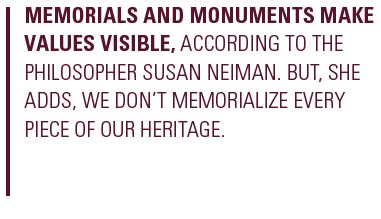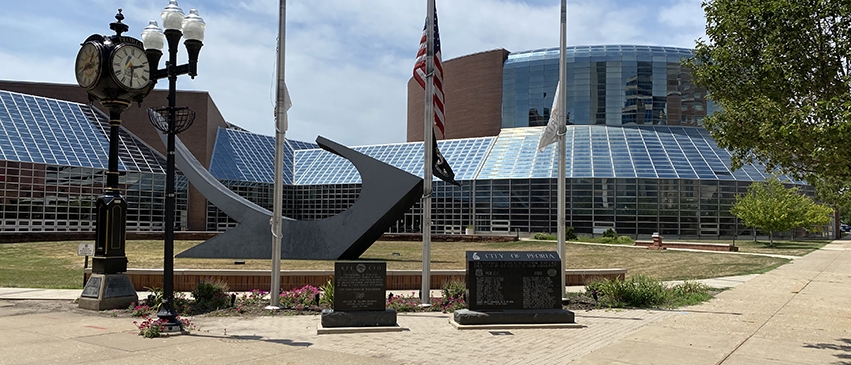There is a framed plaque in the lobby of the Peoria Police Department next to the receptionist desk. I remember a long, impressive stone plaque. It was not there recently. Perhaps my memory is wrong. But my memory is correct about what’s on the plaque: the names of police officers who died in the line of duty.
From William Murphy, shot while trying to make an arrest in 1903, to Donan James Faulkner, shot and killed in 2001, to Cristy Tindall, who died in a car accident in 2004, the plaque honors every officer who died in the line of duty in the history of the Peoria Police Department.
I am struck by the enduring power of naming names, reminded of the dangers officers face as they serve and protect. Their lives matter.
Fourteen officers, minus Theophil Seyller, the first Peoria officer killed in the line of duty, whose shooting death in 1854 was discovered after the plaque was made and placed in the lobby.
Fifteen officers in the police department’s entire history, in nearly 200 years of policing. All 15 are included in a more expansive memorial outside Peoria City Hall, along with the names of Peoria firefighters who died in the line of duty. The officers’ names and photos are part of a larger display of antique weapons, posters and other law enforcement artifacts in the basement of the police department, known as the Gary W. Poynter Peoria Police Museum.
Let us not forget Peoria County Deputy Sheriffs who died on the job. Four since 1922 and the last two in particular: Sgt. Ray Espinoza in 1970 and Deputy Sheriff John Sack in 1987.
Fifteen in the city of Peoria, four more in Peoria County, a total of 19 over two centuries. I am struck by the long reach of memory, who we remember, and why it is important they be remembered.
Making Values Visible
Memorials and monuments make values visible, according to the philosopher Susan Neiman. “They portray the men and women who embodied the values we want our community to share, that we want our children to learn.” But, Neiman adds, we don’t memorialize every piece of our heritage.
History is the record of what we evoke and what we avoid.
What if there was another list, I wonder when I encounter police memorials. What if there was a remembrance engraved with the names of everyone killed by police in the history of Peoria? Everyone who died, in one way or another, in police custody? They are the names least likely to appear on plaques in police departments and memorials in front of city halls. Their deaths may have occurred as they committed a serious crime or turned a gun towards an officer. But not always.
Such a list would include the names of Peorians whose lives were lost only recently. Eddie Russell Jr. in 2017. Daniel El in 2018. Luis Cruz, also in 2018. David Smith in 2019. Four in the last three years. Local protesters also want more answers in the death of Traushan Shields, who was found dead in May 2020 after a chase and shootout with police.
 Before these recent shootings, Peoria police officers hadn’t fatally shot anyone since Demetric Mobley in 2008, who reportedly shot at a police car. But I remember deaths that didn’t involve guns by either police or the suspects they were trying to arrest.
Before these recent shootings, Peoria police officers hadn’t fatally shot anyone since Demetric Mobley in 2008, who reportedly shot at a police car. But I remember deaths that didn’t involve guns by either police or the suspects they were trying to arrest.
The death of two-year-old Aniya Alexander, struck by a police van carrying inmates from jail to the police department for a lineup, in 2009. Eugene “Kim” Pitchford, a homeless man who suffocated in 2000 as police tried to restrain him with pepper spray and blows to the head. Like Russell, he had a history of mental illness. Like Thomas Keller in 1997 and Ivan Durflinger in 1990, like all of the problems officers were never meant to handle.
What amazes me is how rarely officers fire weapons in the line of duty. In Peoria, officers have discharged guns just several dozen times since 2007, according to police department statistics. The vast majority of time they were aiming at animals. But when they did aim and fatally shoot at people, the people have almost always been African-American males, at least in this decade.
A more accurate accounting would require searching the bowels of the police department for more than a century’s worth of records, beginning when Black people first began migrating to the city in large numbers. I wonder if the results would provide more insight than we have now, which is simply that most recent fatal encounters with police involve Black men.
A Broader, Deeper History
For many Black citizens, police killings dredge up historic suspicions and painful humiliations carved deeply in the brain. Investigators, judges and juries may rule the officers’ actions justifiable, and the rulings may be legally correct. But that offers little resolution to a people whose existence is filled with messages that their lives matter less.
This is not a quest for a competing memorial or an alternative history. This is one Black woman struggling with how to create a new history out of the long history of racism, inequality and white supremacy. It is possible to create a broader, deeper, more merciful version than the history that followed us to this moment, one that humanizes police officers and all the people they serve, one that solves the problems we want them to solve. We must interrogate everything we think we know, and reimagine what we thought was impossible.
Memorials to fallen officers are concrete, institutionalized expressions of “Blue Lives Matter,” established before the slogan was a slogan. “Black Lives Matter” began as a hashtag and a cry from the streets, rolled around the world like thunder after George Floyd’s videotaped death beneath the knee of former Minneapolis police officer, now defendant, Derek Chauvin. These conflicting histories are always crashing into each other in unexpected ways at unexpected times—like in the midst of a global pandemic.
In 2015, then-FBI Director James Comey gave a speech at Georgetown University entitled “Hard Truths: Law Enforcement and Race.”
“All of us in law enforcement must be honest enough to acknowledge that much of our history is not pretty. At many points in American history, law enforcement enforced the status quo, a status quo that was often brutally unfair to disfavored groups…
“That experience should be part of every American’s consciousness and law enforcement’s role in that experience—including in recent times—must be remembered. It is our cultural inheritance. One reason we cannot forget our law enforcement legacy is that the people we serve and protect cannot forget it, either. So we must talk about our history. It is a hard truth that lives on.”
History matters. PM
Pam Adams is a writer, journalist and former reporter for the Peoria Journal Star. She can be reached at [email protected].




